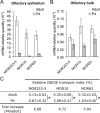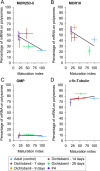Evidence for developmentally regulated local translation of odorant receptor mRNAs in the axons of olfactory sensory neurons
- PMID: 19692593
- PMCID: PMC6665787
- DOI: 10.1523/JNEUROSCI.2443-09.2009
Evidence for developmentally regulated local translation of odorant receptor mRNAs in the axons of olfactory sensory neurons
Abstract
Odorant receptor mRNAs are transported within axons of olfactory sensory neurons that project into the olfactory bulb. Odorant receptor proteins have been identified along the distal part of these axons, which raises the possibility of their local synthesis in axons. We took advantage of the anatomical separation between the olfactory mucosa (which contains the sensory neuron cell bodies) and the bulb (which contains sensory axons but no sensory neuron cell bodies) to address this issue using a quantitative biochemical approach. Combining a method that separates polysome-associated mRNAs from untranslated mRNAs with a reverse transcription-quantitative PCR approach, we demonstrate that significant amounts of odorant receptor mRNAs are associated with polysomes in the sensory axons of the adult mouse bulb. We thus provide the first evidence for local synthesis of odorant receptor proteins in these axons. Interestingly, the rate of odorant receptor mRNA translation in axons is significantly greater during periods when the proportion of immature axons is higher (i.e., at postnatal day 4 or on regeneration after chemical lesion in adults). In contrast, the olfactory marker protein mRNA, which is restricted to mature axons, is translated at a low and constant level. Overall, we demonstrate that translation levels of odorant receptor mRNAs in axons are developmentally regulated, and positively correlated to the stage of axonal growth into the bulb. Given the established function of odorant receptors in the axonal wiring of sensory projections, we propose that this regulated axonal translation may play a role in the development and maintenance of the glomerular array.
Figures





References
-
- Barnea G, O'Donnell S, Mancia F, Sun X, Nemes A, Mendelsohn M, Axel R. Odorant receptors on axon termini in the brain. Science. 2004;304:1468. - PubMed
-
- Brittis PA, Lu Q, Flanagan JG. Axonal protein synthesis provides a mechanism for localized regulation at an intermediate target. Cell. 2002;110:223–235. - PubMed
Publication types
MeSH terms
Substances
LinkOut - more resources
Full Text Sources
